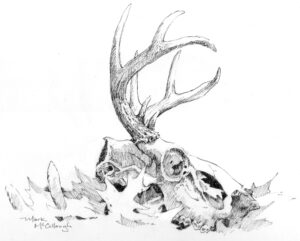Big Belated Buck

BY Mark McCollough
It was a few days after the deer season ended, but I finally got the big buck that I had been dogging all November. I caught several glimpses of him during the deer season. In mid-November I had in my scope on him while he was chasing two does, but he turned to face away from me at the critical moment and my only shot was at his tail end. An unethical shot at best. His beautiful 10-point antlers gleamed in the last light of the setting sun before he grunted and trotted into the fir trees.
Tracking Snow
We finally got a few inches of sleet and fresh snow a week before Christmas. It was a good day for tracking. Coyotes tracks were traveling in pairs prior to their breeding season. Snowshoe hares were keeping to thick cover. It was easy to find their vantage points to watch for predators; always on mounded areas and stumps in the balsam thicket. I tracked a porcupine that chose a cavity under a white pine tip-up for its winter den. The side-by-side tracks of a fisher bounded across the hardwood ridge in its pursuit of prey. Grouse were sticking to the thick cover as well, skirting blowdowns and keeping a low profile.
While tracking hares through a cutover area I almost stumbled across the rack of the 10-point buck covered in the snow. His rib cage and other skeletal remains were nearby. It looked like he died a few weeks ago shortly after the hunting season, a scant 200 yards from the tree stand where I last saw him. He may have expired from injuries sustained during the rut, poor body conditions after the rut, or coyote predation; or all of the above. From his tooth wear, I would guess that he was about 4 ½ years old. The large leg bones were gone so I could not evaluate the condition of the bone marrow. Red and waxy would indicate a healthy deer at the time of death. White and watery means the deer was experiencing malnutrition. It was a sad end to such a noble creature, but such is the way of nature. Most deer die from the sharp fangs of winter or a predator.
Mature Bucks
A surprising number of mature bucks sustain life-threatening injuries during the rut. Some die during the rut or immediately after. Several deer researchers have reported that the majority of natural (non-hunting) mortalities of mature bucks occur from rut-related activities. Several studies of radio-tagged, mature bucks document that 10-20 percent of them die during or immediately after the rut. Like the deer I found, it is difficult to know the actual cause of death; rut-related stress, injury, or predation? Ravens, eagles, coyotes and bobcats are efficient and can consume a deer carcass in a day or two.
Bucks suffer from “testosterone poisoning” during the rut. They nearly cease feeding, and greatly increase their physical activity fighting with other bucks and pursuing does. As a result, they lose about 20-35% of their body weight. Some are weakened by fight-induced injuries. Winter arrives at the same time the rut winds down, and weakened bucks desperately try to make up their body condition deficit. But there is little quality food at this time of the year. Later in the day, I tracked a group of three bucks traveling together. They went from blow down to blow down nibbling lichens from the branches. I could see where some maple saplings were browsed, but it is impossible to regain their lost weight on this meager fare.
I gathered up the old gladiator’s antlered remained and took them home; his last trip down the cornfield. After a day of boiling, trimming, and scrubbing, his white skull hangs on the wall as a reminder of a deer season of close calls. I suspect that a few of his offspring will be out there in the deer woods waiting for me next year.
Mark McCollough hunts deer in his hometown of Hampden, Maine. He can be contacted at [email protected]
For more articles about hunting, fishing and the great outdoors, be sure to subscribe to the Northwoods Sporting Journal.
